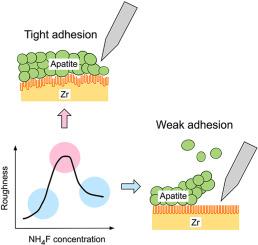电解液中氟化物浓度对氧化锆表面磷灰石层附着的影响
IF 3.5
2区 医学
Q2 ENGINEERING, BIOMEDICAL
Journal of the Mechanical Behavior of Biomedical Materials
Pub Date : 2025-09-17
DOI:10.1016/j.jmbbm.2025.107206
引用次数: 0
摘要
锆具有优异的耐腐蚀性、低磁化率和低细胞毒性,在临床上被用作硬组织修复材料。骨结合能力需要稳定地固定骨中的锆植入物,而在氟化物溶液中阳极氧化已被提出作为实现这一目标的方法。由于腐蚀反应速率和表面晶相随氟化物浓度的变化而变化,因此可以假设电解质中的氟化物浓度会影响骨结合和力学性能。然而,很少有研究对此进行调查。在本研究中,锆在含有0-1 M NH4F的电解液中阳极氧化,并在模拟体液中研究磷灰石的形成,以体外评估骨结合。还研究了磷灰石层与基体的粘附性。NH4F浓度的差异对锆磷灰石形成能力的影响可以忽略不计。但附着力受氟浓度影响较大,中间浓度为0.1 M时附着力最佳。附着力与阳极氧化表面粗糙度有关。本文章由计算机程序翻译,如有差异,请以英文原文为准。

Effect of the fluoride concentration in electrolyte on adhesion of an apatite layer formed on an anodized zirconium surface
Zirconium is used clinically as a material for hard-tissue repair because it has excellent corrosion resistance, low magnetic susceptibility, and low cytotoxicity. Bone-bonding ability is required to stably fix zirconium implants in bone, and anodization in a fluoride solution has been proposed as a method to achieve this. Because the corrosion reaction rate and surface crystalline phase change according to the fluoride concentration, it is assumed that the fluoride concentration in the electrolyte will affect bone bonding and mechanical properties. However, few studies have investigated this. In this study, zirconium was anodized in an electrolyte containing 0–1 M NH4F, and apatite formation in a simulated body fluid was investigated for in vitro evaluation of bone bonding. Adhesion of the apatite layer to the substrate was also investigated. Differences in the NH4F concentration had a negligible effect on the apatite formation ability of zirconium. However, adhesion was greatly affected by the fluorine concentration, with an intermediate concentration of 0.1 M resulting in the best adhesion. Adhesion was correlated with surface roughness of the anodized surface.
求助全文
通过发布文献求助,成功后即可免费获取论文全文。
去求助
来源期刊

Journal of the Mechanical Behavior of Biomedical Materials
工程技术-材料科学:生物材料
CiteScore
7.20
自引率
7.70%
发文量
505
审稿时长
46 days
期刊介绍:
The Journal of the Mechanical Behavior of Biomedical Materials is concerned with the mechanical deformation, damage and failure under applied forces, of biological material (at the tissue, cellular and molecular levels) and of biomaterials, i.e. those materials which are designed to mimic or replace biological materials.
The primary focus of the journal is the synthesis of materials science, biology, and medical and dental science. Reports of fundamental scientific investigations are welcome, as are articles concerned with the practical application of materials in medical devices. Both experimental and theoretical work is of interest; theoretical papers will normally include comparison of predictions with experimental data, though we recognize that this may not always be appropriate. The journal also publishes technical notes concerned with emerging experimental or theoretical techniques, letters to the editor and, by invitation, review articles and papers describing existing techniques for the benefit of an interdisciplinary readership.
 求助内容:
求助内容: 应助结果提醒方式:
应助结果提醒方式:


